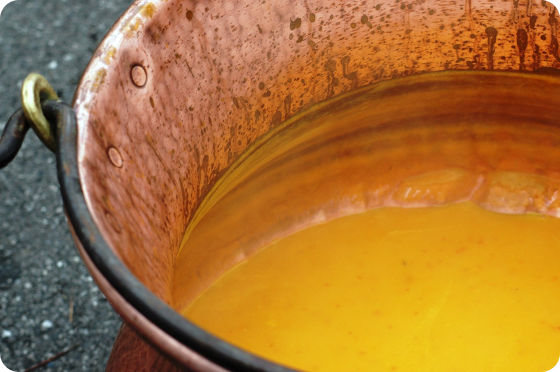I was in one of those fancy boutique culinary stores recently and saw in the refrigerated case row after row of quart jars filled with golden liquid. Over the jars was a sign with two words on it: Bone Broth. After that was the price: $8. It was right about then that I nearly fell over.
For those of you who are unaware, "bone broth" is just a new-fangled word for stock. And stock is simply an infusion, not unlike coffee or tea, typically involving putting stuff like meaty bones, vegetables, and aromatics (think herbs and spices) into water and cook it for a while until the water takes on the flavor and nutrition from the stuff you put in it. You remove the stuff (it's given its all) and you are left with stock. And stock can be an end in itself (anyone with a cold who has warmed stock in a mug and just slurped knows what I'm talking about) or the start of amazing soups, stews, risottos, gravies, sauces … you get the idea. Stock is a great building block in a well-stocked (see what I did there?) kitchen.

For me, I tend to make stock when I have bones on hand. You can make stock with cooked or uncooked bones. The meatier the bones, the more meaty flavor your stock will have have. In the same way, the more and more variety of vegetables you have, the more vegetable flavor your stock will have. You can make stock with just meat or just vegetables, but given that my family and I are omnivores, I tend to make mine with a combination of both, plus usually some fresh herbs, a bay leaf or two, and sometimes even a slice or two of lemon. Remember that your stock will take on the flavors you put into your pot, so choose wisely. When it comes to both meaty bones and vegetable matter, I've been known to save items in large freezer bags until I'm ready to put together a pot. Then I can pick and choose frozen items — no need to thaw them — to build my perfect stock.
A quick note about vegetable matter for stock: When cooking, you often look to carefully trim vegetables or chop them precisely. When making stock, just about anything goes. Make sure your vegetable matter is clean and not rotten. After that, consider keeping your peels, ends, and leaving fairly large pieces. Sometimes, you don't need to cut something at all. Other times, just cutting an onion in half — no peeling required — will do the job. This is part of why I love tossing odds and ends into a large freezer bag. When it comes time to put together stock, I might have everything from the gnarly end of a celeriac root and trimmed pieces from leeks to add to the mix without even having to lift a finger!
When making stock, you should always be sure to have your pot filled with water such that everything in it is completely submerged. After all, you wouldn't make coffee by floating some grounds along the top of some hot water, would you? Stock wants a chance to spend a bit of time up close and personal with the items you've chosen to flavor it. Now, you can make a respectable stock on the stovetop with a slow simmer, in a slow cooker over the course of most of a day, or in a pressure cooker in about an hour. However you choose to make it, understand that boiling isn't the goal. A slow simmer with, at most, some lazy little bubbles is what you are looking for. Trust me, patience will be rewarded.

Once your cook time (which does vary, but let your nose and tastebuds be your guide) has elapsed, let it all cool slightly (making stock is easy, but give it time and avoid burning yourself!) before removing all the solids and ladling it into clean quart jars. I like to set a metal mesh covered in cheesecloth into the opening of the jar to catch the very small particulate in the stock. Once you've sealed your jars with lids and allowed them to cool enough to be easily handled, you can move them to your refrigerator and use them for all manner of delicious dishes. Any time a recipe calls for water and you'd like to see a little more savory flavor, turn to your stock! When you want soup, having homemade stock on hand means you're minutes away. If you find you have a dish that is a bit dry and needs a flavor boost, there's no better way to do just that than adding a bit of this liquid treasure.
And don't be afraid to try your hand at more than just chicken stock. While that's the variety I make most often, I also make beef stock by just saving the bones from my roasts until I have enough for a small batch. Seafood stock is easy when you save your shrimp shells and fish bones. And when I have a ham bone, I can't help but put together the intense stock it can provide. I also love making a rich vegetable stock, especially when my garden is nearing its overwhelming period in late August and early September. And, of course, there's nothing like a turkey carcass to make turkey stock a snap! I tend to make stock at least once a month and it's rare for me to not have at least a jar or two of it in the back of my refrigerator at all times. And, given that it's mostly made from items I have on hand and might otherwise toss, the cost involved boils (or simmers, rather!) down to the time I've invested in making it. And that, my friends, is time very well spent.
